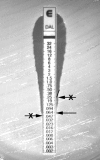Activity of dalbavancin tested against Staphylococcus spp. and beta-hemolytic Streptococcus spp. isolated from 52 geographically diverse medical centers in the United States
- PMID: 17215346
- PMCID: PMC1829082
- DOI: 10.1128/JCM.02368-06
Activity of dalbavancin tested against Staphylococcus spp. and beta-hemolytic Streptococcus spp. isolated from 52 geographically diverse medical centers in the United States
Abstract
Dalbavancin is a lipoglycopeptide antimicrobial agent with a potency significantly better than that of vancomycin when tested against staphylococci and streptococci. These two pathogens are common causes of skin and skin structure infections (SSSIs), and dalbavancin has been approved for the treatment of moderate to severe SSSIs. This study generated susceptibility data for staphylococci and beta-hemolytic streptococci from 52 U.S. medical centers that locally tested dalbavancin, vancomycin, and other antimicrobial class representatives to assess the potency of dalbavancin and the overall contemporary activities of commonly prescribed agents. Locally generated data showed that oxacillin-resistant staphylococci (57.0% overall) had slightly higher dalbavancin MIC(90) values (0.19 microg/ml) than oxacillin-susceptible strains (0.125 microg/ml). This potency was 8- to 16-fold greater than that for vancomycin. beta-Hemolytic streptococci had MIC(90) values ranging between <or=0.016 and 0.064 microg/ml (highest for group B isolates). Levofloxacin, gentamicin, and tetracycline were active against oxacillin-susceptible staphylococci (82 to 99% susceptible), with lower susceptibility rates seen for the oxacillin-resistant strains. Linezolid coverage was >98% against staphylococci. Erythromycin resistance was high for staphylococci (30.6 to 94.1%) with inducible clindamycin resistance rates of 26.0% and 55.0% for oxacillin-susceptible and -resistant Staphylococcus aureus, respectively. Beta-hemolytic streptococci had a 20.2% erythromycin resistance rate and a 60% inducible clindamycin resistance rate but were highly susceptible to other tested agents. Etest reading errors were apparent and skewed results towards slightly higher dalbavancin MICs, requiring further education on how to interpret Etest method results for this compound. Current disk diffusion breakpoint criteria for oxacillin susceptibility for S. aureus showed a very-major-error rate of 2.3% and only a 0.9% minor-error rate when cefoxitin was used to predict oxacillin susceptibility. Dalbavancin demonstrated excellent potency and activity (100% susceptibility at proposed breakpoints) against common causes of SSSI pathogens in this U.S. multicenter study sample.
Figures



References
-
- Biedenbach, D. J., J. M. Stephen, and R. N. Jones. 2003. Antimicrobial susceptibility profile among β-haemolytic Streptococcus spp. collected in the SENTRY Antimicrobial Surveillance Program-North America, 2001. Diagn. Microbiol. Infect. Dis. 46:291-294. - PubMed
-
- Biedenbach, D. J., M. A. Toleman, T. R. Walsh, and R. N. Jones. 2006. Characterization of fluoroquinolone-resistant β-hemolytic Streptococcus spp. isolated in North America and Europe including the first report of fluoroquinolone-resistant Streptococcus dysgalactiae subspecies equisimilis: report from the SENTRY Antimicrobial Surveillance Program (1997-2004). Diagn. Microbiol. Infect. Dis. 55:119-127. - PubMed
-
- Bowker, K. E., A. R. Noel, and A. P. Macgowan. 2006. Pharmacodynamics of dalbavancin studied in an in vitro pharmacokinetic system. J. Antimicrob Chemother. 58:802-805. - PubMed
-
- Carmeli, Y., C. Rothermel, D. Sheehan, P. Hogan, and M. Mendelson. 2006. Abstr. 46th Intersci. Conf. Antimicrob. Agents Chemother., abstr. L-1211.
Publication types
MeSH terms
Substances
LinkOut - more resources
Full Text Sources
Medical
Miscellaneous

